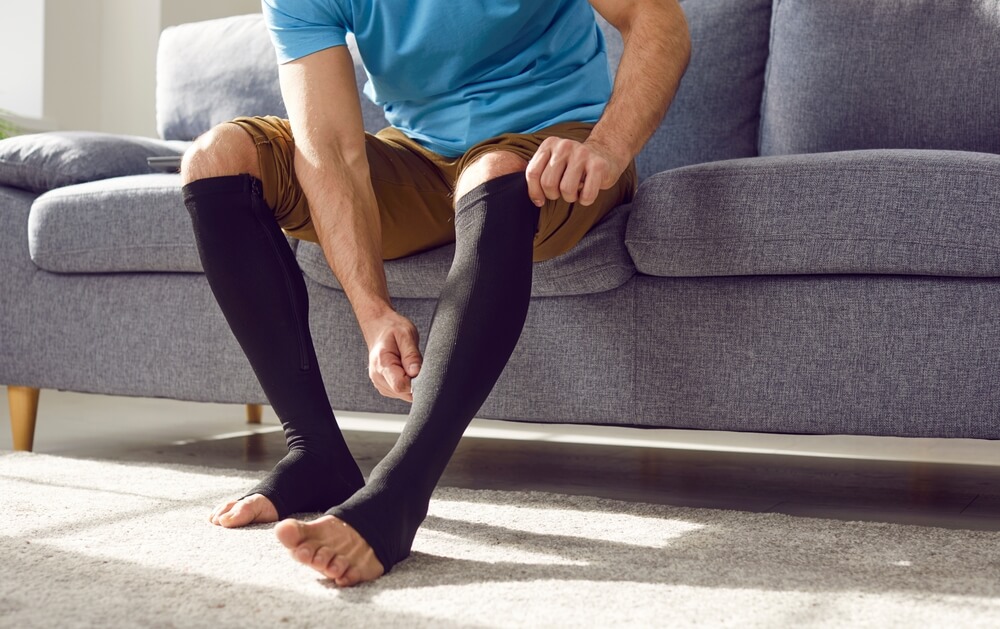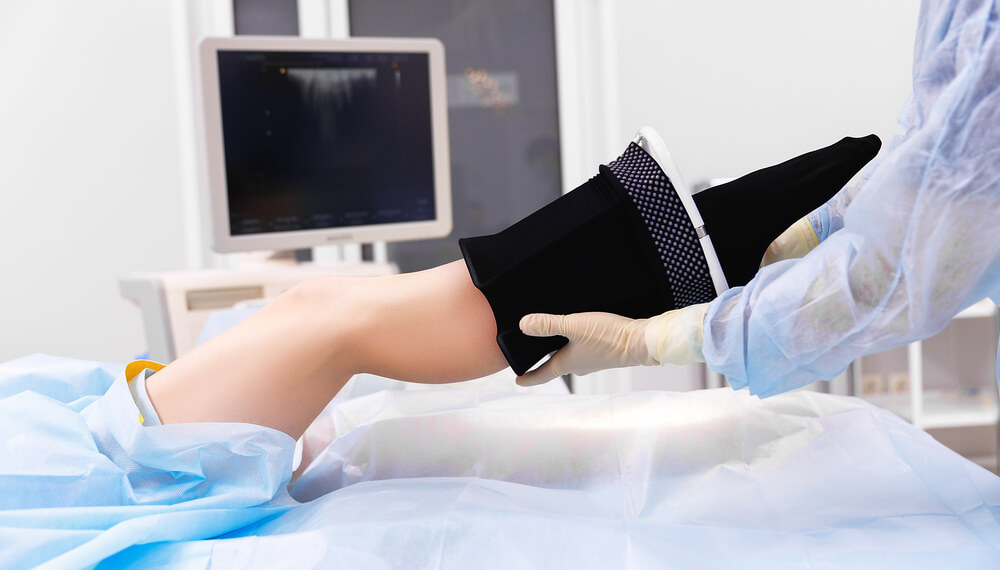Compression Stockings: Benefits, Types, and How to Choose the Right Pair

Have you ever wondered if those snug-looking compression socks could make a difference for your legs? If you’re dealing with tired, achy legs, varicose veins, or swelling, you’re not alone. Millions of people turn to compression stockings each year to improve their leg health and feel more comfortable.
But with so many options, it can be overwhelming to figure out what’s right for you. The good news is that choosing the right pair doesn’t have to be complicated. Let’s explore how to choose them and how these simple yet powerful tools can support your vein health and help you take the next step—comfortably.
How to Choose Compression Stockings
With so many styles, compression levels, and sizes, it’s important to choose compression stockings that fit your unique needs. The right pair can make all the difference in managing symptoms like leg pain, improving blood flow, and even preventing blood clots.
But how do you know which ones are right for you? Several factors come into play when choosing the right compression stockings.
Understanding Compression Levels
The compression level is one of the most important factors to consider when choosing compression stockings. Compression levels are measured in millimeters of mercury (mmHg) and indicate how much pressure the stockings apply to your legs.
Selecting the right compression level depends on your specific needs and medical conditions. Always consult with your healthcare provider to determine the level that’s best for you. Here’s a breakdown of the most common levels:
- Mild compression (8-15 mmHg): Ideal for every day use, this level is perfect for relieving mild swelling, improving blood circulation, or providing light support during long periods of sitting or standing. It’s also great for preventing spider veins or early signs of venous disease.
- Moderate compression (15-20 mmHg): This level is recommended for managing varicose veins, mild leg pain, and preventing blood clots during travel or pregnancy. It’s also a popular choice for those experiencing mild chronic venous insufficiency.
- Firm compression (20-30 mmHg): Often prescribed for more severe conditions, this level is used to treat severe varicose veins, manage symptoms of deep vein thrombosis, and reduce significant swelling caused by venous disease.
- Extra-firm compression (30-40 mmHg or higher): This level is reserved for advanced medical needs, such as managing severe chronic venous insufficiency, preventing post-surgical complications, or addressing significant blood flow issues. They require a prescription and should only be used under medical supervision.
Types of Compression Stockings Available
Various styles of compression stockings are available, designed to cater to different needs and preferences. Of course there are traditional knee-high, thigh-high, and pantyhose/full-length stockings. Other more specialized types include:
- Graduated compression stockings: These are tighter at the ankle and gradually loosen as they go up the leg. They help promote proper blood flow and prevent blood clots, especially for those with limited mobility or long-term travel needs.
- Anti-embolism stockings: Designed specifically for individuals recovering from surgery or at high risk of developing deep vein thrombosis, these provide consistent compression to reduce the likelihood of clot formation.
- Medical compression socks: These socks are tailored for therapeutic purposes like compression therapy and are often prescribed for managing significant vein conditions or post-surgical recovery.
Choosing Between Knee-High, Thigh-High, and Pantyhose Styles
Selecting the right style of compression stockings depends largely on your specific condition and the area of your legs that needs support. Consider your specific needs, comfort, and lifestyle when choosing the most suitable style.
Knee-high stockings end just below the knee and are an excellent choice if your symptoms, such as swelling or discomfort, are primarily in your lower legs. They’re convenient for daily wear, less restrictive, and easy to pair with casual or professional attire. If you spend long hours standing or sitting, knee-high compression socks work effectively to prevent fluid buildup and improve blood circulation.
Thigh-high stockings are a better option for those dealing with more advanced conditions like severe varicose veins or significant swelling that extends above the knee. They provide support for the entire leg, ensuring proper blood flow from the foot to the thigh.
Meanwhile, pantyhose-style compression stockings offer comprehensive coverage from toes to waist, making them ideal for individuals experiencing widespread symptoms or during pregnancy when pelvic support is beneficial.
Measuring for the Right Fit
Getting the proper fit for compression stockings ensures they work effectively and feel comfortable. Ill-fitting stockings can compromise their benefits or even cause discomfort. To measure accurately, start with a soft measuring tape and take measurements first thing in the morning when swelling is minimal.
How you measure depends on the type of stocking:
- Knee-high stockings: Measure the circumference of your ankle at its narrowest point and your calf at its widest point. You’ll also need the length of your leg from the floor to just below the knee.
- Thigh-high stockings: Add a measurement around the widest part of your thigh and the length from the floor to the top of your thigh.
- Pantyhose-style compression stockings: Take additional measurements around your hips and waist.
Sizes may vary, so be sure to check the manufacturer’s sizing chart. Consulting with a healthcare provider or specialist can also ensure you choose the perfect fit.

Material Considerations for Comfort and Durability
Most stockings are made from a blend of elastic fibers like spandex or Lycra, combined with materials such as nylon or cotton. This provides necessary stretch and support along with breathability and comfort for extended wear. If you have sensitive skin or allergies, look for stockings made with hypoallergenic materials or soft cotton blends to prevent irritation.
Durability is another important factor, especially if you plan to wear compression socks daily. High-quality medical compression socks are designed to withstand frequent washing and retain their elasticity over time. If you’ll use them in warmer climates or for physical activities, opt for moisture-wicking fabrics to keep your legs cool and dry.
Investing in well-made stockings can save you money in the long run because they’ll maintain their effectiveness and last longer. Always follow the care instructions to preserve their material integrity.
When and How to Wear Compression Stockings
Knowing when and how to wear compression stockings can make a big difference in their effectiveness. These stockings are designed to work with your body’s natural circulation, so timing and proper usage matter. Wearing them the right way gives you maximum comfort and health benefits. Consider some simple strategies that can help you get the most out of your compression socks.
When to Wear Compression Stockings
Knowing the right times to wear compression stockings ensures you get maximum benefit from them. Depending on your lifestyle and health needs, there are several situations when these stockings can provide valuable support:
- During long periods of standing or sitting
- While traveling
- After surgery
- During pregnancy
- For exercise or physical activity
- Daily for chronic vein issues like chronic venous insufficiency or severe varicose veins
How to Wear Compression Stockings
Wearing compression stockings correctly is essential for them to work effectively and comfortably. Start by putting them on first thing in the morning when your legs are least swollen. Sit in a comfortable position and gently roll the stocking down the toe area.
Place your foot inside with your toes and heels properly aligned, and then gradually roll or pull the stocking up your leg. Avoid bunching the fabric because this can create pressure points and reduce the stocking’s effectiveness.
Make sure the stocking lies flat against your skin without wrinkles or folds, as these can lead to discomfort or uneven compression. If you’re wearing thigh-high stockings or pantyhose, adjust them carefully to make sure they stay securely in place.
Use donning gloves or a stocking aid if you have difficulty putting them on. Avoid cutting or modifying your stockings, as this can compromise their compression level and durability.
Find the Perfect Fit for You with Nelson Vein
Caring for your veins doesn’t have to be complicated. Whether you’re dealing with varicose veins, swelling, or simply looking to improve your leg health, the right pair of compression stockings can make all the difference. By choosing the right fit, material, and compression level, you’re taking an active step toward better comfort and circulation.
At Nelson Vein & Surgical Services, we understand that vein health is personal and overwhelming. Our compassionate expert team is here to guide you through every step with tailored solutions and minimally invasive treatments that fit your unique needs. We provide treatments and compassionate support every step of the way.
Let us help you find the perfect pair of compression stockings and provide the expert care you deserve. Contact us today to schedule an appointment and see why no one can take better care of you than we can.
